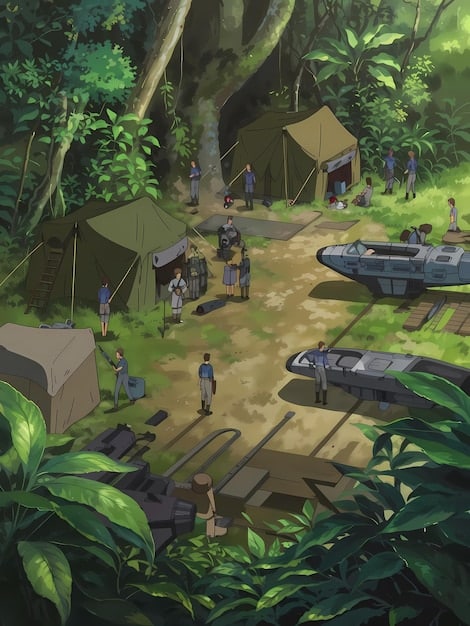Counter-Jungling Guide: Disrupt the Enemy Jungler in Patch 14.12

Counter-jungling in Patch 14.12 involves invading the enemy’s jungle to steal resources, disrupt their farming, and ultimately hinder their impact on the game, requiring strategic vision, coordination, and understanding of jungle matchups.
Want to dominate your League of Legends games in Patch 14.12? Learn the art of counter-jungling to deny resources and cripple the enemy jungler’s game plan. This comprehensive guide will equip you with the knowledge and strategies to control the jungle and lead your team to victory.
Understanding the Basics of Counter-Jungling
Counter-jungling is a high-risk, high-reward strategy. It’s not just about stealing camps; it’s about applying pressure, gaining vision, and setting the enemy jungler behind. A successful counter-jungle can snowball into a significant advantage for your team, leading to early objective control and map dominance. But what exactly makes a successful counter-jungle?
At its core, counter-jungling involves invading the enemy’s jungle to steal their resources: camps, buffs, and even experience. This denies them gold and experience, hindering their ability to gank lanes, control objectives, and scale into the late game. However, more than just stealing camps, effective counter-jungling is about applying strategic pressure, creating opportunities for your team, and forcing the enemy jungler into reactive plays.
Assessing the Risks and Rewards
Before stepping into the enemy jungle, you must weigh the potential rewards against the risks. Consider the following:
- Your Champion’s Strength: Is your champion strong enough to duel the enemy jungler if you encounter them?
- Lane States: Are your laners in a position to assist if you get into trouble, or will they arrive too late?
- Vision Control: Do you have sufficient vision to track the enemy jungler’s movements and avoid getting caught out?

A successful counter-jungle nets your team with more than just buffs or camps. It can leave the enemy jungler frustrated, demoralized, and less effective throughout the match. But an unsuccessful one can cost you time, resources, and potentially hand the enemy team an advantage.
When done right, counter-jungling can heavily swing the balance of power. But it must be executed with caution and knowledge.
Identifying Ideal Counter-Jungling Opportunities
Not every moment is ripe for a jungle raid. Recognize those golden opportunities when the stars align, and the enemy jungle is at its most vulnerable. This requires knowing when the enemy jungle is low on health or on the other side of the map
Tracking the Enemy Jungler
Knowledge is power. Knowing the enemy jungler’s location and clear path is crucial for planning safe and effective counter-jungles. You can predict this by:
- Early Game Tracking: Pay attention to which side of the map the enemy jungler starts on and track their movements based on camp respawn timers.
- Vision Control: Place deep wards in the enemy jungle to gain continuous vision of their movements.
- Communication: Ask your laners to provide information about the enemy jungler’s movements or recent ganks.
It’s not just about knowing *where* they are, but also *when* they’ll be somewhere. Predicted movements is how counter jungling becomes successful.
Capitalizing on Ganking and Objective Focus
Exploit those times when the enemy jungler is preoccupied with other objectives. When they are:
- Ganking a Lane: Take advantage of their absence in the jungle to steal camps or buffs on the opposite side of the map.
- Securing Objectives: While they’re focused on Dragon or Rift Herald, invade their jungle to disrupt their farming and potentially steal a camp.
- Low Health: If you spot them in low health, seek them out for an easy kill
Be sure to communicate with your teammates. Team play can easily turn the tides of battle.
Mastering counter-jungling is not just about knowing the theoretical aspects, but about actively reading the map, understanding the game state, and making calculated decisions based on the available information.
Champion Selection and Matchup Considerations
Your champion choice plays a pivotal role in your counter-jungling success. Some champions excel at invading and dueling, while others are better suited for farming and ganking. Picking the optimal champion is therefore of the utmost importance.
Ideal Counter-Jungling Champions
Champions with high mobility, strong dueling potential, and good early game damage are ideal for counter-jungling. Examples include:
- Lee Sin: High mobility and strong early game damage make him a formidable invader.
- Elise: Can quickly burst down camps and has a strong engage with her Cocoon.
- Graves: Excellent clear speed and dueling potential, making him a terror in the enemy jungle.

These champions can quickly enter the enemy jungle, secure resources, and either escape safely or win a duel if challenged.
If you notice the enemy has picked any of the champions above, you might want to select a tank that can easily withstand any initial attacks.
Understanding Matchup Dynamics
Consider the champion matchups when planning a counter-jungle. A favorable matchup can give you the edge needed to win a duel and secure resources, while a disadvantageous matchup can lead to a quick death and a setback for your team. Some matchups include:
A Rengar would have an easier time than a Karthus, due to his immense burst and invisibility. Someone like Shaco would have an incredible amount of time picking off single players.
Champion matchups are not always a 100% indication of success. Player skill and strategy also matter.
Effective Ward Placement for Jungle Control
Strategic ward placement is the cornerstone of successful counter-jungling. Vision control allows you to track the enemy jungler’s movements, anticipate their plans, and safely invade their jungle. Make sure to place wards wisely.
Deep Warding Strategies
Deep wards provide valuable information about the enemy jungler’s movements and camp status. Ideal locations for deep wards include:
- Buff Camps: Warding the enemy’s Red or Blue buff camps allows you to track when they are being taken and plan your invades accordingly.
- Jungle Entrances: Placing wards at the entrances to the enemy jungle provides early warning of their movements and allows you to react accordingly.
- Key Pathways: Warding pathways between jungle camps can help you track the enemy jungler’s clear path and identify opportunities for invades.
These wards should be placed far enough into the enemy jungle to provide early warning, but not so far that they are easily detected and destroyed.
Placing wards on the opposite side of the jungle from your main lanes to avoid the enemy ganking can really change everything.
Defensive Warding Techniques
While deep wards are important for tracking the enemy jungler, defensive wards can help protect you from counter-ganks and allow you to escape safely from invades. These wards should be placed with the goal of quickly letting you know of approaching enemies.
- River Bush: Placing a ward in the river bush provides vision of approaching enemies and allows you to react to ganks.
- Jungle Entrances: Warding your own jungle entrances can provide early warning of enemy invades and allow you to prepare a counter-attack.
Remember to upgrade your trinket to a sweeper lens as soon as possible to clear out enemy wards and deny them vision of your movements.
Maximizing Resource Denial: Buffs, Camps, and Gold
The primary goal of counter-jungling is to deny the enemy jungler resources, slowing down their leveling and hindering their ability to impact the game. Take their resources, such as buffs, camps and gold.
Stealing Buffs and Objectives
Stealing buffs is one of the most effective ways to cripple the enemy jungler. Denying them a crucial Red or Blue buff can significantly impact their ganking or farming potential. Therefore, it is best if you can focus on stealing buffs.
- Timing is Key: Track the buff respawn timers to know when they will be up and plan your invade accordingly.
- Smite Usage: Be prepared to use your Smite to secure the buff, even if it means burning Flash to get into range.
- Team Coordination: Communicate with your laners to let them know when you’re planning to steal a buff and ask for assistance if needed.
Also stealing drakes and Rift Herald can provide an immense leg up on the enemy.
Maximizing resource denial through strategic counter-jungling can significantly impact the game’s outcome, giving your team a decisive advantage in the mid and late game.
Optimizing Clear Speed and Efficiency
While denying the enemy resources is important, you also need to ensure that you are efficiently clearing your own jungle. It does not matter if you take all of the enemies camps if you can not maintain your own camp.
Counter-jungling requires a delicate balance between aggression and efficiency, playing the right amount of defensive. Be ready to play both sides!.
Adapting to Different Game States and Team Compositions
Counter-jungling is not a one-size-fits-all strategy. You need to adapt your approach based on the game state, team compositions, and enemy behavior. Every game is a new story, and should be treated as such!
Adjusting to Early, Mid, and Late Game
Your counter-jungling strategy should evolve as the game progresses.
- Early Game: Focus on securing early vision, tracking the enemy jungler, and stealing buffs when the opportunity arises.
- Mid Game: Transition from reactive counter-jungling to proactive objective control, using your vision and map awareness to set up ganks and secure dragons.
- Late Game: Prioritize protecting your carries, securing vision around key objectives, and counter-jungling only when it is safe and advantageous.
Playing the game slowly and methodically will win you games. Make sure you have planned the entire game before it happens.
| Key Point | Brief Description |
|---|---|
| ⚔️ Champion Selection | Choose champions with high mobility and strong dueling potential. |
| 👁️🗨️ Vision Control | Place strategic wards to track enemy movements and secure your jungle. |
| 💰 Resource Denial | Steal buffs, camps, and gold to hinder the enemy jungler’s progress. |
| 🔄 Game Adaptation | Adjust your strategy based on the current game state and team compositions. |
FAQ
▼
Counter-jungling is the act of invading the enemy’s jungle to steal resources, deny them experience and gold, and disrupt their overall game plan. It’s a high-risk, high-reward strategy.
▼
Vision control allows you to track the enemy jungler’s movements, anticipate their plans, and safely invade their jungle. It also helps you avoid getting caught out by the enemy team.
▼
Champions with high mobility, strong dueling potential, and good early game damage are ideal for counter-jungling. Examples include Lee Sin, Elise, and Graves.
▼
Assess the risks and rewards before invading the enemy jungle. Consider your champion’s strength, lane states, vision control, and the enemy jungler’s location.
▼
If you get caught counter-jungling, try to fight back if you have a chance, or use your mobility to escape. If you can’t escape, call for help from your teammates.
Conclusion
Mastering the art of counter-jungling can significantly elevate your gameplay and influence the outcome of your League of Legends matches. By understanding the core principles, assessing the risks and rewards, and adapting your strategy based on the game state, you can become a formidable force in the jungle, disrupting the enemy’s plans and leading your team to victory.





